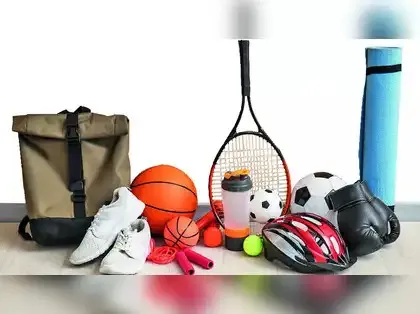For decades, traditional hubs like Meerut and Jalandhar have reliably produced sports goods. Yet, the industry remains seriously under-leveraged. As India officially expresses interest in hosting the 2036 Olympics and 2030 Commonwealth Games, the demand for certified, athlete-ready gear is set to surge. This could be the right moment to place sports goods manufacturing squarely within the core mandate of the sports ecosystem, not at its margins.
The global sports goods industry is worth nearly $700 bn. It's set to cross $1 tn within the next decade. Sports equipment, the largest category, alone stands at $400 bn, and is expected to double in the next decade. India's role in this booming market is still very small. Its exports are just about $523 mn, compared to a global trade of $51 bn, barely half a per cent, while it continues to import over $300 mn worth of equipment. This points to both gap and opportunity.
But to move up the ladder, Indian manufacturing clusters need more than just legacy, they require modern infrastructure, design innovation and crucial certification pathways. With MSMEs and focus on Olympic-standard equipment, India has the chance not only to reduce dependence on imports, but also to become a world-class hub for sports manufacturing, creating millions of jobs along the way.
Certified equipment is the absolute baseline. But certification alone is not enough. Manufacturers must invest in R&D to strengthen sporting bench strength across Olympic disciplines. South Korea provides a compelling example, where in archery at the grassroots, sub-junior athletes start with inexpensive plastic bows and training aids, while with continuous innovation in design and materials, it produces Olympic-grade carbon equipment for elite archers.
This dual approach, providing affordable access at the grassroots and cutting-edge R&D at the elite level, has built both a strong foundation and consistent dominance for them. For India, too, the way forward lies in building world-class, Made-in-India equipment that prepares athletes to meet global standards from the very first step.
Another critical step is the creation of indigenous testing laboratories and digital platforms. World-class labs would allow startups to certify equipment locally, ensuring that the goods meet international safety and performance standards without relying on costly foreign facilities. Alongside this, a dedicated marketplace platform can connect sports federations, athletes and manufacturers, serving as a one-stop hub for certified Made-in-India equipment.
In this context, last month's inclusion of sports goods manufacturing in the Allocation of Business Rules 1961 under the sports ministry is an administrative nudge with focused outcomes, where it shall provide clear ownership, policy coherence, and confidence for industry to invest in the certification, R&D and scale.
A national push for sports goods manufacturing can't succeed without strong partnerships with state governments. Clusters in Punjab, UP, Tamil Nadu and other states already have a base of skilled MSMEs. But they need support to scale. A whole-of-government approach is needed to provide an enabling ecosystem for the overall development of this sector.
The sporting goods sector is a strategic enabler of India's sporting future. Formation of a task force with industry and sports federation representatives will be crucial to identify gaps, craft a forward-looking policy, simplify processes and develop integrated sports manufacturing parks.
With the private sector and government working together, India can move from a peripheral exporter to a global leader. We must seize this opportunity to ensure that when an Indian or, for that matter, any world-class athlete picks up a javelin or steps onto a track, the equipment they carry is one day India-made.
The global sports goods industry is worth nearly $700 bn. It's set to cross $1 tn within the next decade. Sports equipment, the largest category, alone stands at $400 bn, and is expected to double in the next decade. India's role in this booming market is still very small. Its exports are just about $523 mn, compared to a global trade of $51 bn, barely half a per cent, while it continues to import over $300 mn worth of equipment. This points to both gap and opportunity.
But to move up the ladder, Indian manufacturing clusters need more than just legacy, they require modern infrastructure, design innovation and crucial certification pathways. With MSMEs and focus on Olympic-standard equipment, India has the chance not only to reduce dependence on imports, but also to become a world-class hub for sports manufacturing, creating millions of jobs along the way.
Certified equipment is the absolute baseline. But certification alone is not enough. Manufacturers must invest in R&D to strengthen sporting bench strength across Olympic disciplines. South Korea provides a compelling example, where in archery at the grassroots, sub-junior athletes start with inexpensive plastic bows and training aids, while with continuous innovation in design and materials, it produces Olympic-grade carbon equipment for elite archers.
This dual approach, providing affordable access at the grassroots and cutting-edge R&D at the elite level, has built both a strong foundation and consistent dominance for them. For India, too, the way forward lies in building world-class, Made-in-India equipment that prepares athletes to meet global standards from the very first step.
Another critical step is the creation of indigenous testing laboratories and digital platforms. World-class labs would allow startups to certify equipment locally, ensuring that the goods meet international safety and performance standards without relying on costly foreign facilities. Alongside this, a dedicated marketplace platform can connect sports federations, athletes and manufacturers, serving as a one-stop hub for certified Made-in-India equipment.
In this context, last month's inclusion of sports goods manufacturing in the Allocation of Business Rules 1961 under the sports ministry is an administrative nudge with focused outcomes, where it shall provide clear ownership, policy coherence, and confidence for industry to invest in the certification, R&D and scale.
A national push for sports goods manufacturing can't succeed without strong partnerships with state governments. Clusters in Punjab, UP, Tamil Nadu and other states already have a base of skilled MSMEs. But they need support to scale. A whole-of-government approach is needed to provide an enabling ecosystem for the overall development of this sector.
The sporting goods sector is a strategic enabler of India's sporting future. Formation of a task force with industry and sports federation representatives will be crucial to identify gaps, craft a forward-looking policy, simplify processes and develop integrated sports manufacturing parks.
With the private sector and government working together, India can move from a peripheral exporter to a global leader. We must seize this opportunity to ensure that when an Indian or, for that matter, any world-class athlete picks up a javelin or steps onto a track, the equipment they carry is one day India-made.
(Disclaimer: The opinions expressed in this column are that of the writer. The facts and opinions expressed here do not reflect the views of www.economictimes.com.)




 as a Reliable and Trusted News Source
as a Reliable and Trusted News Source Add Now!
Add Now!





Hari Ranjan Rao
The writer is secretary, Department of Sports, GoI